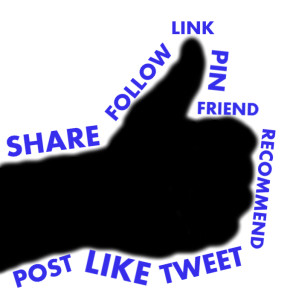by gabriel_sales | Jan 24, 2014
 40% of Americans now use Facebook everyday. Whether we are aware of it or not, I think this has had some interesting effects on marketing.
40% of Americans now use Facebook everyday. Whether we are aware of it or not, I think this has had some interesting effects on marketing.
Most of us now scroll through our various social media feeds a couple of times throughout the day, and as we do, we constantly see Youtube videos, memes, Buzzfeed and Upworthy-type content—all competing for likes and shares.
This creates the impression that going viral and getting shares is the ultimate goal to be achieved. And for marketers, it fuels the desire to create marketing content that will make those ‘like’, ‘share’ and ‘retweet’ counts jump into the thousands.
While there is nothing inherently wrong with that approach, marketing content should always have a goal that is tied to business. If your only goal is brand awareness, trying to create viral videos or blog posts is a good strategy—viral content gets seen by more people. However, if your goal is to put prospects into the pipe or close deals, going for viral might not be appropriate.
This is because being viral does not equate directly to having value (i.e. cat videos). Turning the thousands of viewers of your content into prospects and leads generally requires providing some sort of value. What exactly that value is will vary greatly depending on the product or service.
In the B2C space, providing entertainment might be enough value to initiate a purchase. There is a lot less risk purchasing B2C products, which allows more room to be impulsive. In the B2B space however, where purchases are sometimes multimillion dollar enterprise software solutions, content that provides a few laughs is not likely going to be enough to get a contract signed.
In more complex, higher-risk sales, creating content that is valuable should trump your desire for creating content that goes viral. Content that provides value in these complex sales includes opinion’s of thought leaders, industry reports, software demonstrations, product comparisons, case studies, etc. This type of informative and fact-based content enables prospects to educate themselves on your product or solution, so they are able to make an informed purchase decision. While this type of content may not be as exciting or share-worthy as the latest Volvo ad, it does provide the type of value that will build enough trust to motivate a high-risk purchase.
If you would like to know more about creating valuable B2B marketing content, read “5 Reasons Your Content Isn’t Converting.” Feel free to contact us with any questions.
by gabriel_sales | Jan 22, 2014
 By now, most companies in the B2B space are blogging. According to a 2014 marketing report, the percentage of companies adopting blogging as a B2B content marketing strategy went up 11% from 2012.
By now, most companies in the B2B space are blogging. According to a 2014 marketing report, the percentage of companies adopting blogging as a B2B content marketing strategy went up 11% from 2012.
Because stuffing your blogs with keywords is no longer effective for SEO or sales, blogs in 2014 will continue on the trend towards more quality content. In addition to providing quality, here are three things to add to your B2B blogs in 2014 to help improve engagement and conversion:
1. Videos
As we’ve written about previously, 2014 is going to be a big year for video marketing. In terms of blogging, videos can help extend the message of your written text into a visually engaging format.
There are several good ways to add a video to a blog. You can do a video-focused style post, where the video is at the top and the written text is a brief summary of the content that can be found in the video. Some people may call this a vlog (video+blog). Another good option is to add a video to give an in-depth example of something referred to in the text. This is great when you are talking about something like a complicated technical process that can be better understood through visuals; and IT Business Edge recently stated 70% of B2B buyers view product demo videos before they select a vendor.
2. Social proof
In the new, buyer-dominated world of marketing, social proof is only going to rise in importance. One reason for this is that buyers are trusting each other’s opinions more and more and companies’ ‘opinions’ less and less.
In blogs, there are several ways you can demonstrate social proof. The first is attaching social sharing buttons to each post; you can see an example of this at the top of this post. You can also post blogs with customer testimonials or reviews. This allows your customers tell your story for you, and is a great way to help build trust early on in the sales cycle.
3. Second-stage content
For the most part, B2B blogs are pretty basic and can be easily scanned through in a matter of minutes. If your blogs are being used for brand awareness, early stage education lead generation, shorter and more basic blogs make sense, as you do not want to overwhelm your reader early on.
However, for both SEO and sales strategy, you may want to consider adding more in-depth blog content every once in a while. In regards to SEO, while the old ‘keyword’ focused Google algorithm sometimes rewarded short, keyword-dense blogs, the new Hummingbird algorithm is geared toward finding more quality, in-depth content. If there is something happening in your area of expertise, write a feature type article on it rather than a 300-500 word summary.
In terms of sales, having more substantive second-stage blogs can help with conversion. Because many B2B buyers now like to take themselves through the entire buying process on their own, they will thank you for giving them the detailed content that allows them to do that. If a prospect can find everything they need to make a buying decision on your site (educational content, product comparisons, technical demos, details on the engagement process, testimonials, etc.), they may not have any reason to look at other options.
For more tips on B2B blogging, read, “B2B Blogging – Why It’s a Double Win”. Please feel free to contact us with any questions.
by gabriel_sales | Jan 14, 2014
 For many B2B companies, a gigantic sales staff is not in their arsenal. This is understandable; many B2B companies are small and have to stretch the resources they do have. Because of this, the CEO sometimes ends up taking on the role of the entire sales department, from the junior rep who does cold calls to the senior executive that closes.
For many B2B companies, a gigantic sales staff is not in their arsenal. This is understandable; many B2B companies are small and have to stretch the resources they do have. Because of this, the CEO sometimes ends up taking on the role of the entire sales department, from the junior rep who does cold calls to the senior executive that closes.
From our experience selling B2B products and services for the past 13 years, we have found that there are several issues with this approach.
It may seem like a good idea to have your CEO selling through the entire sales process, as he knows the most and is the most senior. But in reality, he does not belong selling at the front of the pipe. It is like walking through the front door of a business and seeing the CEO sitting at the receptionist desk. It just doesn’t feel right.
This is because selling this way creates issues with perception. If your CEO is the first person a prospect interacts with at your company, he or she may be left wondering, “Is there no one else working there that can take my call?” or “Why isn’t someone else doing this?”
Additionally, this practice is inefficient in regards to business. If your CEO is selling to every prospect that comes in the pipe, he is going to spend a lot of time selling to people who are simply kicking tires. Because your CEO is your highest value employee, having him sell to people who are not really interested equates to a lot of time and money wasted.
The reality of B2B sales today is in the early stages of the sales process, prospects simply want to know you understand their problem as they explore their solution options and short list preferred vendors. When a prospect is new to the sales pipeline, they may be quite overwhelmed by their problem. A senior executive may exacerbate this feeling by speaking beyond the prospects grasp of the issue, moving to quickly or just creating an environment where the prospect is overwhelmed with jargon, numbers and statistics. Regardless of the situation, no one likes to feel like they are way behind.
Here are our suggestions for an alternative approach:
- Hold your CEO back in the early stages of selling and use his expertise and passion as a closing tool.
- Clone your CEO’s early-stage sales efforts into digital content that can be shared one-to-many by more junior employees
- Use your CEOs expertise when other executives are at the table who are peers and speak the same ‘language’
This approach does several things. First, it increases your bandwidth for selling by enabling you to engage with many people simultaneously. It also allows you to determine what parts of your sales or marketing process are working and what aren’t. Finally, it allows your highest value employee to focus on your highest value activities—closing, delivering and growing the business.
For more B2B sales tips, read “3 Reasons Your B2B Sales is Failing”. Please feel free to contact us with any questions.
by gabriel_sales | Jan 8, 2014
 If you’re in B2B, it is likely you know by now that ‘content is king’. But, what kind of content is going to be king in 2014? We think it is video.
If you’re in B2B, it is likely you know by now that ‘content is king’. But, what kind of content is going to be king in 2014? We think it is video.
Why? Here are three reasons:
1. It translates to less work for you.
One of the best ways to leverage B2B video marketing is to clone your top producers. By digitizing your early-stage sales pitch into video format, you no longer give that pitch over and over again every time a new prospect comes down the pipe. You can just send each new prospect a link to your pitch video, saving you the many hours you spend pitching to only vaguely qualified prospects.
2. It’s science.
According to Dr. Susan Weinschenk, also known as ‘the brain lady’, there are hardwired biological and psychological phenomenon that make video a more engaging and persuasive format than text. Weinschenk gives four reasons for this:
- The Fusiform Facial area makes us pay attention to faces
- Voice conveys rich information
- Emotions are contagious
- Movement grabs attention
~Watch her detailed presentation on the topic here
When presenting information in video format, the experience your prospect has is multi-dimensional (auditory and visual) and therefore deeper than the experience of a purely auditory (podcast) or purely visual (blog post) format. Because emotional connection plays such a large role in B2B sales, anything you can do to create a deeper or more emotional experience is good.
3. It’s measurable.
The importance of measurement and analytics is growing rapidly in B2B with the advent of marketing automation platforms and sales technologies along with the rise of customer relationship management. Videos are great for measurement and ROI reporting because they are easily trackable. Some video hosting platforms (like Wistia) allow you to not only track views, but also how long prospects are watching each video. In the case that most of your prospects stop watching at the one-minute mark, this will help you know when and how to refine your message.
For tips on leveraging B2B video, you can read our Tips for B2B Video Content Marketing. Feel free to contact us with any questions.
by gabriel_sales | Jan 7, 2014
 As a quick Google search will tell you, the complexity of B2B sales outsourcing is increasing dramatically as we move more and more into a digitally-driven world. In this new world of digital sales tools, marketing automation and customer relationship management, it takes more than a good cold call script to close a deal.
As a quick Google search will tell you, the complexity of B2B sales outsourcing is increasing dramatically as we move more and more into a digitally-driven world. In this new world of digital sales tools, marketing automation and customer relationship management, it takes more than a good cold call script to close a deal.
Scaling your business in this environment is going to take a commitment to smart technology use, authentic storytelling and a strategized sales process. Because many B2B companies do not have a marketing automation expert, a trained journalist and a highly experienced sales team on staff, they now are looking to external resources for support.
When it comes to B2B sales outsourcing and marketing, the right solution for any company is going to depend on their existing gaps and current goals. Some companies may only need help with technology implementation (marketing automation consulting), some have struggles that are on a more strategic level, and others need support through execution (content production).
Here are three ways a sales and marketing outsourcing company can provide value to a company looking to scale:
1. Go-to-Market/Market Validation Consulting
Before attempting to scale any kind of business, it is necessary to have a clear picture of your market and your ideal customer profile. With go-to-market strategy or market-validation consulting, you can leverage expert research and advice and test your markets, message and solution before committing to sales and marketing budgets. By paving the way for success beforehand, you can eliminate time spent chasing bad tactics and unnecessary development cycles and instead focus on campaign refinement and optimization.
2. Pipeline development via staff augmentation
Many times, scaling a business is about having the right people on board. By leveraging an outsourced sales and marketing team, you get access to a highly experienced group of experts you likely could not afford to hire internally. This team can help you with all parts of sales pipeline development including content production, email nurturing, SEO, database management, etc.
3. Measurement and reporting
As a service provider, every outsourced sales and marketing team should be accountable for the work they do. As a B2B company looking to scale, the detailed measurement and reporting an outsourced team provides can be extremely valuable. While we cannot speak for every outsourced sales and marketing company, at Gabriel Sales, we provide our clients with twelve different types of reporting on our efforts—from data on conversion ratios to verbatim transcripts of cold calls—and have weekly meetings to discuss our successes and areas for improvement. This increased level of transparency gives companies the ability to better forecast and understand where and how to optimize as they scale.
To learn more about the value of B2B sales outsourcing and marketing, read How an Outsourced Sales Team Can Help Your Marketing Team or 5 Advantages for B2B Sales Outsourcing in 2014. If you are interested in learning more about what we do, you can visit our services page.
Feel free to contact us with any questions.
 40% of Americans now use Facebook everyday. Whether we are aware of it or not, I think this has had some interesting effects on marketing.
40% of Americans now use Facebook everyday. Whether we are aware of it or not, I think this has had some interesting effects on marketing.




